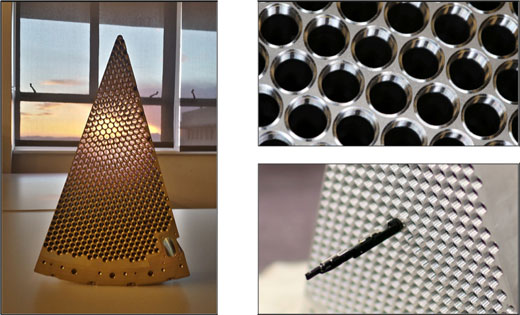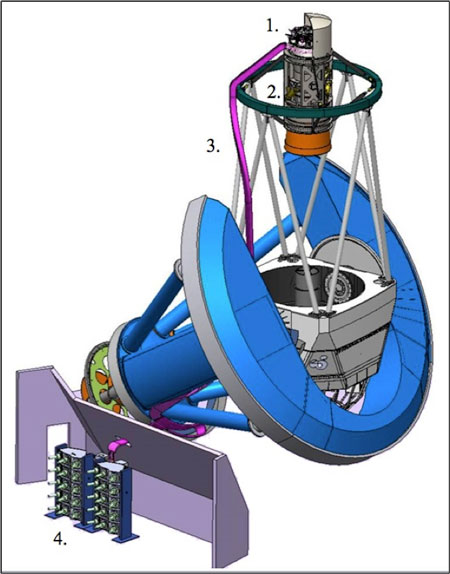| Aug 09, 2016 |
3-D galaxy-mapping project enters construction phase
|
|
(Nanowerk News) A 3-D sky-mapping project that will measure the light of millions of galaxies has received formal approval from the U.S. Department of Energy to move forward with construction. Installation of the project, called DESI (Dark Energy Spectroscopic Instrument), is set to begin next year at the Nicholas U. Mayall 4-meter telescope at Kitt Peak National Observatory near Tucson, Ariz., with observations starting up in January 2019.
|
|
This latest DOE approval step, known as Critical Decision 3, triggers spending for major components of the project, including the remainder of the 5,000 finger-width, 10-inch-long cylindrical robots that will precisely point the fiber-optic cables to gather the light from a chosen set of galaxies, stars, and brilliant objects called quasars. The spending will also be used to complete the set of 10 fiber-fed spectrographs that will precisely measure different wavelengths of incoming light.
|
|
This light will tell us about the properties of the galaxies, stars, and quasars, and most importantly, how quickly they are moving away from us—light from objects that are moving away from us is shifted to redder wavelengths (“redshift”). These details can help us learn more about the nature of dark energy that is driving the accelerating expansion of the universe. DESI’s observations will provide a deep look back in time, up to about 11 billion years ago.
|
 |
| The first “petal” machined for the Dark Energy Spectroscopic Instrument (DESI) is shown in these photos. Ten of these petals, which together will hold 5,000 robots (like the one in the lower right photo)—each pointing a thin fiber-optic cable at separate sky objects—will be installed in DESI. (Images: Joe Silber/Berkeley Lab)
|
|
“We’re very excited—ecstatic—that we’ve gotten to this step,” said DESI Director Michael Levi of Lawrence Berkeley National Laboratory’s (Berkeley Lab) Physics Division.
|
|
“This brings DESI closer to its five-year mission to go where no map has gone before in the universe,” added David Schlegel of Berkeley Lab, a co-project scientist for DESI. “I can’t wait.”
|
|
DESI’s robotic array will cycle through separate sets of objects several times each hour during its five-year mission. It will look at one-third of the sky and will capture more than 10 times as much data as a predecessor called BOSS, the Baryon Oscillation Spectroscopic Survey.
|
|
DESI will provide a more detailed look at the patterned clustering of visible matter in the night sky across a larger range of distances. This clustering was set in motion by a cooling process in the early universe that produced sound wave-like oscillations through a combination of pressure and gravitational forces. DESI will also provide a more precise measure of how the universe has spread out over time, and help us understand galaxy evolution and dark matter, which is invisible but inferred from its gravitational effects on normal matter.
|
 |
| The Dark Energy Spectroscopic Instrument (DESI), shown in this illustration, will be mounted on the 4-meter Mayall telescope at Kitt Peak National Observatory near Tucson, Ariz. It will collect data on light from 35 million galaxies and quasars to make the biggest 3-D map of the universe ever. (Image: R. Lafever, J. Moustakas/DESI Collaboration)
|
|
“The DESI map of galaxies will reveal patterns that result from the interplay of pressure and gravity in the first 400,000 years after the Big Bang,” said Daniel Eisenstein of Harvard University, a DESI co-spokesperson. “We’ll be using these subtle fingerprints to study the expansion history of the universe.”
|
|
The DESI collaboration has grown to include about 300 scientists and engineers from about 45 institutions around the globe. The leadership team includes Robert Besuner of the UC Berkeley Space Sciences Laboratory, who has stepped in as the new DESI project manager. He replaces Henry Heetderks of the Space Sciences Laboratory, who retired June 29.
|
|
The project’s multiple sources of financial support and its use of an existing telescope have helped to keep DESI on a fast track, Levi said. “Now the hard work accelerates,” he added.
|
|
With the latest approval, a pipeline of development efforts will move quickly toward completion. Six large lenses, each worth $1 million and measuring up to 1.1 meters in diameter, await treatment with an antireflective coating to improve their transparency.
|
|
The lenses will be housed in a metal frame being constructed at Fermi National Accelerator Laboratory (Fermilab) to form a minivan-sized stack known as an optical corrector. This device will be the first piece of equipment installed at the Mayall Telescope for DESI in 2018.
|
|
To prepare for DESI data analysis, software engineers are using supercomputers at Berkeley Lab’s National Energy Research Scientific Computing Center (NERSC) to simulate the data gathered by DESI. NERSC is a DOE Office of Science User Facility.
|
|
Also, three sky surveys are now collecting images of the faint galaxies that DESI will target. Data from these surveys is periodically released on a public site at legacysurvey.org, and observational data gathered by DESI will also be publicly released.
|
|
“I like to think of the imaging surveys as building the 2-D maps, while DESI adds the third dimension,” said Dustin Lang, a DESI imaging scientist with the University of Toronto. ”The crucial third dimension allows us to measure how galaxies cluster together in space over the history of the universe.”
|
|
A prototype instrument called ProtoDESI is now installed at the Mayall Telescope for a two-month run. ProtoDESI uses four small robots to test out the fiber-positioning system and includes cameras and other components to prepare for the full DESI project.
|
|
“This is a great time to be an astroparticle physicist. DOE’s program of building new instruments like DESI will provide the data that will let us take the next step in understanding the formation of our universe,” said Fermilab’s Brenna Flaugher, co-project scientist for DESI and project manager of DECam, the camera for the Dark Energy Survey, an ambitious imaging survey currently underway.
|
|
DESI is one of several planned next-generation observatory projects designed to confront cosmic mysteries including dark energy, dark matter, and the universe’s first light, known as the cosmic microwave background.
|
|
“DESI will be able to make a 3D map of the universe using an order of magnitude more redshifts than currently exist,” said Risa Wechsler of the SLAC National Accelerator Laboratory, Stanford University and DESI co-spokesperson. “This will allow us to probe the physics of the universe and discover the true nature of dark energy.”
|


